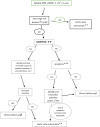Serum copeptin might improve risk stratification and management of aortic valve stenosis: a review of pathophysiological insights and practical implications
- PMID: 30803406
- PMCID: PMC6376527
- DOI: 10.1177/1753944719826420
Serum copeptin might improve risk stratification and management of aortic valve stenosis: a review of pathophysiological insights and practical implications
Abstract
Over recent decades, the prevalence of aortic valve stenosis (AVS) has been constantly increasing possibly owing to the aging of general population. Severe AVS as determined by an aortic valve area (AVA) of <1 cm2 has been regarded as a serious clinical condition potentially associated with a variety of adverse outcomes, including sudden cardiac death (SCD). However, patients with severe AVS (in the absence of overt high-risk features) are usually evaluated and managed exclusively based on symptomatology or imperfect prognostic tools including exercise testing and biomarkers, with a potential risk of mismanagement, suggesting the need for further objective risk stratifiers in this setting. Within this context, copeptin (C-terminal pro-vasopressin), a novel neurohormone widely considered as the surrogate marker of the arginine-vasopressin (AVP) system, may potentially serve as a reliable prognostic and therapeutic guide (e.g. timing of aortic valvular intervention) in patients with severe AVS largely based on its hemodynamic, fibrogenic as well as autonomic implications in these patients. Accordingly, the present paper aims to discuss clinical and pathophysiological implications of copeptin in the setting of AVS along with a summary of biomarkers and other prognostic tools used in this setting.
Keywords: aortic valve stenosis; copeptin; prognostic implication; prognostic tool; therapeutic implication.
Conflict of interest statement
Figures

Similar articles
-
The integrated value of sST2 and global longitudinal strain in the early stratification of patients with severe aortic valve stenosis: a translational imaging approach.Int J Cardiovasc Imaging. 2017 Dec;33(12):1915-1920. doi: 10.1007/s10554-017-1203-2. Epub 2017 Jun 29. Int J Cardiovasc Imaging. 2017. PMID: 28664478
-
Outcome Implication of Aortic Valve Area Normalized to Body Size in Asymptomatic Aortic Stenosis.Circ Cardiovasc Imaging. 2016 Nov;9(11):e005121. doi: 10.1161/CIRCIMAGING.116.005121. Circ Cardiovasc Imaging. 2016. PMID: 27903539
-
Advanced symptoms are associated with myocardial damage in patients with severe aortic stenosis.J Cardiol. 2017 Jul;70(1):41-47. doi: 10.1016/j.jjcc.2016.10.006. Epub 2016 Nov 19. J Cardiol. 2017. PMID: 27876412
-
Contemporary application of cardiovascular hemodynamics: transcatheter aortic valve interventions.Cardiol Clin. 2011 May;29(2):211-22. doi: 10.1016/j.ccl.2011.01.002. Cardiol Clin. 2011. PMID: 21459244 Review.
-
Transcatheter aortic valve implantation: anesthetic considerations.Anesth Analg. 2009 May;108(5):1453-62. doi: 10.1213/ane.0b013e31819b07ce. Anesth Analg. 2009. PMID: 19372319 Review.
Cited by
-
Novel Biomarkers and Advanced Cardiac Imaging in Aortic Stenosis: Old and New.Biomolecules. 2023 Nov 17;13(11):1661. doi: 10.3390/biom13111661. Biomolecules. 2023. PMID: 38002343 Free PMC article. Review.
-
Serum Copeptin in Cardiooncology Practice: Review of Pathophysiological and Clinical Implications.Balkan Med J. 2023 Mar 8;40(2):82-92. doi: 10.4274/balkanmedj.galenos.2023.2023-2-14. Balkan Med J. 2023. PMID: 36883738 Free PMC article.
-
Insights into calcific aortic valve stenosis: a comprehensive overview of the disease and advancing treatment strategies.Ann Med Surg (Lond). 2024 Apr 29;86(6):3577-3590. doi: 10.1097/MS9.0000000000002106. eCollection 2024 Jun. Ann Med Surg (Lond). 2024. PMID: 38846838 Free PMC article. Review.
References
-
- Nishimura RA, Otto CM, Bonow RO, et al. ; ACC/AHA Task Force Members. 2014 AHA/ACC guideline for the management of patients with valvular heart disease: executive summary: a report of the American College of Cardiology/American Heart Association Task Force on practice Guidelines. Circulation 2014; 129: 2440–2492. - PubMed
-
- Falcão-Pires I, Leite-Moreira AF. Biomarkers of aortic valve stenosis: should we rely on a single one? Rev Port Cardiol 2016; 35: 579–582. - PubMed
-
- Lim P, Monin JL, Monchi M, et al. Predictors of outcome in patients with severe aortic stenosis and normal left ventricular function: role of B-type natriuretic peptide. Eur Heart J 2004; 25: 2048–2053. - PubMed
Publication types
MeSH terms
Substances
LinkOut - more resources
Full Text Sources
Miscellaneous

